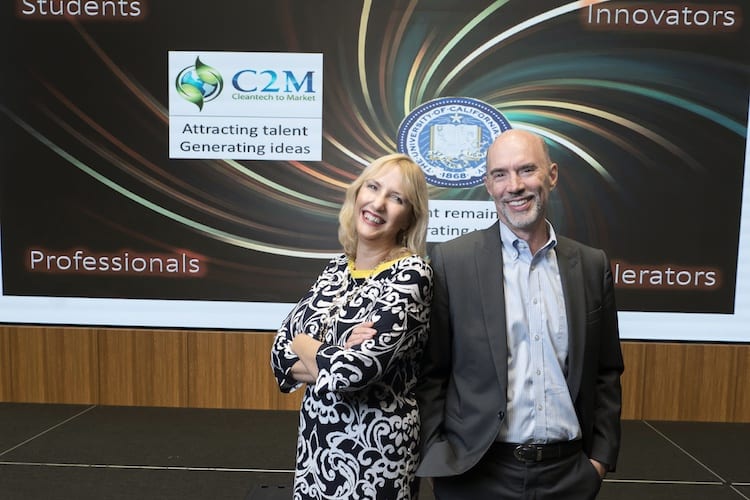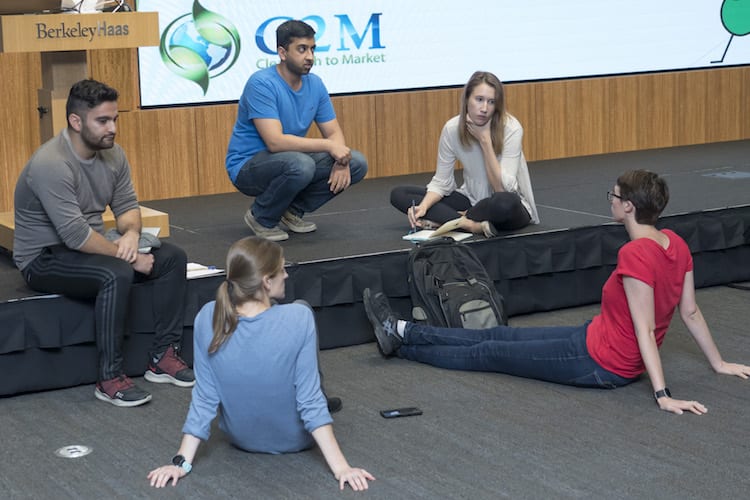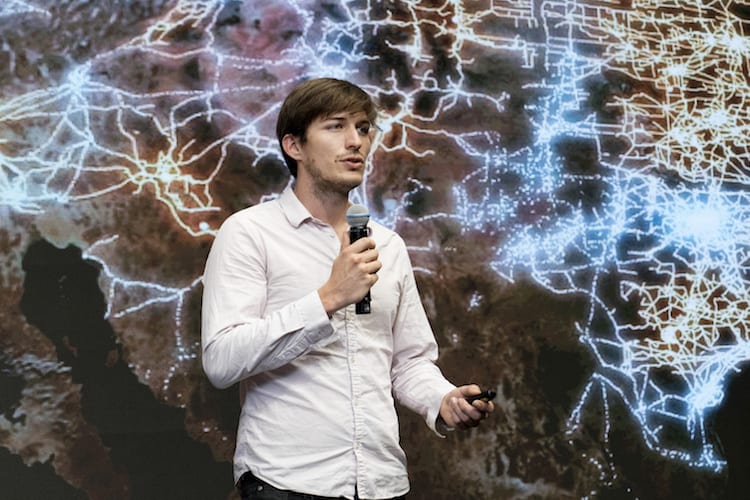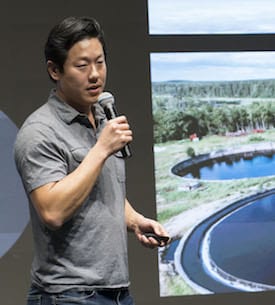
Jenny Bailey, MBA 19, sat in a circle with her Cleantech to Market team in Spieker Forum on Tuesday, talking about cyanobacteria. More specifically, how to sell them for use in skincare.
“I’m not sure we should call them skincare solutions,” Bailey said, as teammates weighed in on how to define a skincare product line for startup HelioBioSys, which has developed cost-effective ways to harvest and process the bacteria, commonly found in oceans.
The students are among six teams — comprising 20 MBA students and 11 graduate students from engineering, biology, law, and other Berkeley schools — who will present their findings and recommendations to more than 200 alumni, faculty, students, and industry professionals at the 10th annual Cleantech to Market (C2M) Symposium in Chou Hall on Friday. In addition to two awards decided by the audience, judges will also award a $5,000 C2M Cleantech Award, sponsored by Wells Fargo.

The C2M program, launched a decade ago, pairs students with scientists to help push promising technologies to market. With CO2 levels the highest in human history, the need to develop viable clean tech startups has never been more critical, says director Bev Alexander. Alexander runs the program with co-director Brian Steel and C2M faculty member Bill Shelander, a trio affectionately known as “B3” for their first names.
“Cleantech to Market grew out of an environmental urgency and it’s only grown more urgent,” Alexander says. “We’re giving students so much freedom to innovate here at a time when California has put a stake in the ground as an antidote to shifting federal government priorities.”
Indeed, California is leading the way on renewables and sustainable energy initiatives, and Berkeley is an epicenter — with C2M an influential part of the ecosystem. Over the past decade, the program has paired more than 300 researchers and startup founders with student teams. C2M pays off for these clean tech companies, which have collectively raised more than $142 million and employ about 300 people, Alexander says.
More women leading teams
This year’s new crop of teams will add to that success, by pitching ways for startups to commercialize a variety of new technologies.
There’s Dauntless.io, which works on adaptive machine learning for multiple applications; Opcondys, which is focused on power switching using light instead of electricity; Mosaic Materials, which is building metal-organic frameworks for gas separation; Lucent Optics, which developed light-redirecting film for efficient natural lighting; and Treau, which makes lightweight heat exchangers to decarbonize heating, ventilation, and air conditioning (HVAC). Notably, half of the six student team leads this year are women, a program record. “I’m really encouraged and inspired by this,” says Bailey, who is a team lead.

Steel and Alexander have nurtured C2M from a small, student-led pilot connecting scientists at Lawrence Berkeley Lab with graduate students on campus, to a marquis program that’s forged tight alliances with state agencies like the California Energy Commission and federal agencies including the U.S. Department of Energy, top universities, and a network of incubators. “We’ve gone from a local pilot to a national pipeline,” Alexander says. “We used to go ask people at Lawrence Berkeley Lab if we could work on their technologies, and now we have people from all over the country applying for just six to eight slots in our program. Our alumni are among the ‘who’s who’ of this industry.” To date, more than 400 graduate students — paired with scientists and researchers throughout the 15-week program— have completed the C2M course.
Getting the technology out of the lab
Among the first was Brooks Kincaid, MBA 11, who co-founded battery technology storage startup Imprint Energy with UC Berkeley PhD student Christine Ho. It was one of the first startups to come out of C2M. “This was her technology, her baby,” Kincaid recalls. “She was pretty engaged and spent a lot of time with our team but had no concept of how to commercialize it.”
Kincaid, who had an engineering background, worked closely with Ho, and the pair gained some traction by the program’s end, along with a grant that enabled Ho to continue the work in her PhD lab. As president and CEO of Imprint, Kincaid focused on getting a license agreement in place, hiring the team, and getting seed money from Dow Chemical, a longtime C2M sponsor.
By the time Kincaid left Imprint Energy to pursue a finance career in 2014, the Alameda, Ca.-based company had raised about $9 million. “The technology made it out of the lab and survived,” he said. “But we’re also a good example of the time and energy and patience required to develop a cleantech innovation.”

C2M was originally conceived as an extracurricular project by Lawrence Berkeley Lab and students in the Berkeley Energy Resources Collaborative, or BERC, a multidisciplinary student organization. Prof. Catherine Wolfram brought the pilot into the Energy Institute at Haas, hiring Alexander and Cyrus Wadia, now vice president of sustainable business & innovation at Nike, as the first faculty co-directors.
Students who led the way
Students who helped launch the program have gone on to their own cleantech industry success. They include Naveen Sikka, MBA 09, CEO of biofuel startup TerViva, which was named to the list of top 25 AgTech startups by Forbes for the past two years; Adam Lorimer, MBA 10, who co-founded Alphabet Energy in 2009; and Christy Martell, MBA 10, is now a sales lead at energy storage company Stem. Martell says she appreciated working on a diverse C2M team with students majoring in English and public health. As a C2M coach, she’s among more than 1,000 cleantech industry pros who have served as class speakers, mentors, subject matter experts, and interviewees over the past decade.

“It’s so much more structured now, and so much more impactful for the students from a career perspective,” Martell says. “Bev and Brian and the team make sure the students get good exposure to the labs and the different technologies. And the level of research that goes into market plans — asking an open-ended question like, ‘Is this technology viable, and if so, in what market?’ and distilling that into a discrete plan — is so helpful for the students.”
The C2M annual cycle begins in January, when Steel, Alexander, and Shelander meet with leaders from the Department of Energy, Berkeley-based fellowship program Cyclotron Road, the Cleantech Open (which trains early-stage entrepreneurs), and the California Energy Commission to winnow down a list of possible startups. “It really helps to have knowledgeable partners referring pre-vetted technologies,” Steel says. One example is Howard Yuh, a UC Berkeley graduate who is founder and CEO of GreenBlu, a solar desalination startup. Alexander met Yuh through the Cleantech Open, inviting his startup to work with a C2M team in 2017.
Student teams are chosen in April and May, and projects kick off in August, culminating with a year-end symposium presentation and a 100-page report assessing the technology and recommending paths to market.
The course paid off for Maxwell Kushner-Lenhoff, MBA 18, whose team won two of the awards at last year’s symposium. But Kushner-Lenhoff, who is now a global supply manager of battery materials at Tesla, says there were bumps along the way in completing a project for the wastewater treatment technology startup MICROrganic Technologies. By the middle of the course, his team ranked itself poorly for effectiveness, and had to figure out how to turn the project around.
Kushner-Lenhoff says C2M is the reason he chose Haas. “No other program rivals C2M on meaningful engagement with cleantech startups,” he says. “These companies are banging on the door to have C2M teams work with them.”
Cleantech to Market Symposium (and 10th Anniversary Celebration)
Date: Friday, Nov. 30, 9-4:30 pm
Location: Spieker Forum, Chou Hall
Speakers:
- Maxwell Kushner-Lenhoff, a global supply manager of battery materials at Tesla
- Howard Yuh, founder and CEO, GreenBlu
- Ryan Hanley, MBA 11, general manager of Shell’s Energy Platform
- Sebastien Lounis, UC Berkeley PhD, applied science and technology and co-founder of Cyclotron Road
- Jill Fuss, founder and CTO of startup CinderBio, a project lead at Cyclotron Road, and a research scientist at Lawrence Berkeley Lab
- Erik Stokes, chief of the energy deployment and market facilitation office of the California Energy Commission
Judges:
- Kathleen Jurman, technology scout at Dow Ventures
- Joshua Posamentier, MBA 13, co-founder and managing partner at Congruent Ventures
- Jeremy Nowak, PhD candidate (Chemistry), UC Berkeley